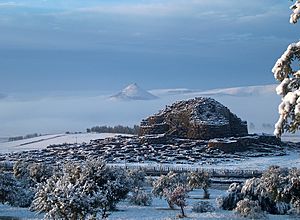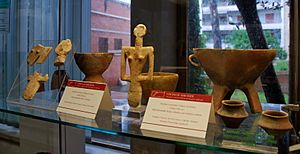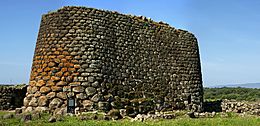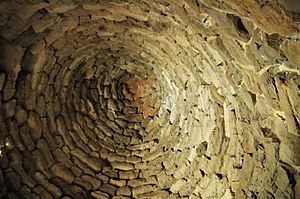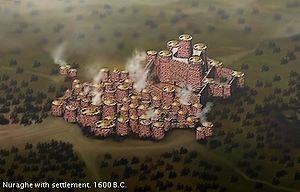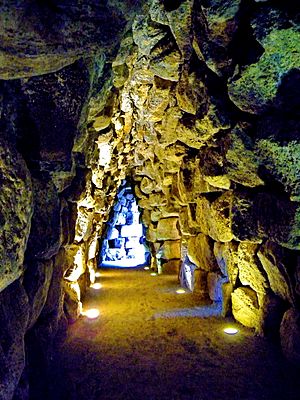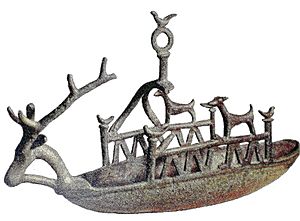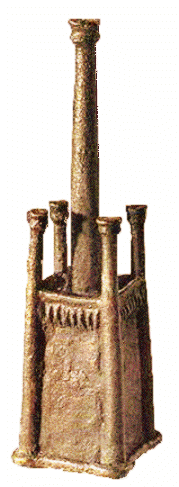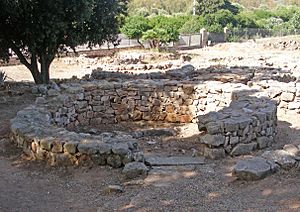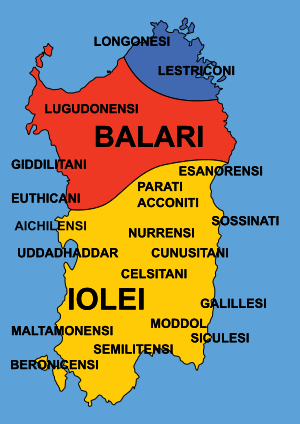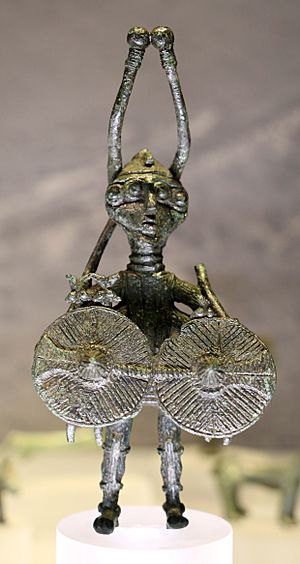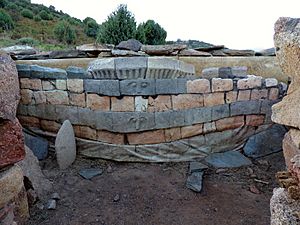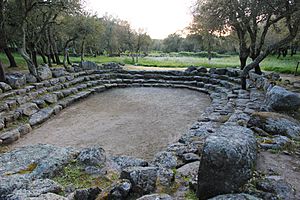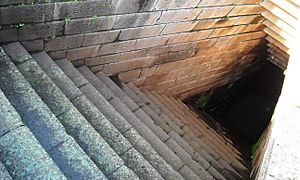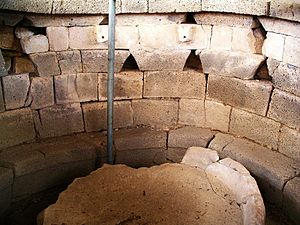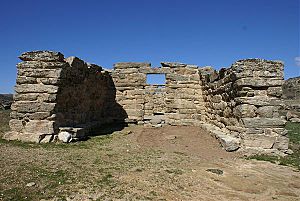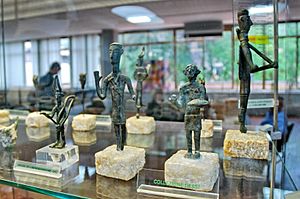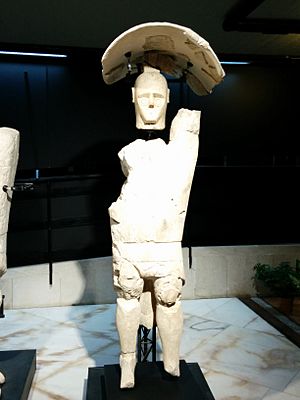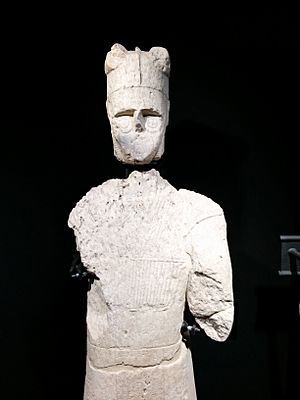Nuragic civilization facts for kids
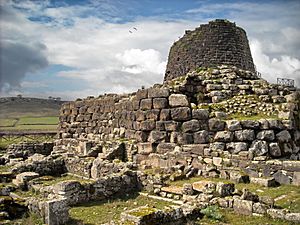
The Nuragic civilization was an ancient culture that lived on the island of Sardinia, Italy. This civilization lasted for a very long time, from about 1800 BCE (which is the Middle Bronze Age) until the Romans took over in 238 BCE. Some experts believe it lasted even longer in certain parts of the island.
The name "Nuragic" comes from the most famous buildings they left behind: the nuraghe. These were tower-like fortresses that the ancient Sardinians built in huge numbers. Today, you can still see more than 7,000 nuraghes across Sardinia.
We don't have any written records from the Nuragic people themselves. Most of what we know comes from what the ancient Greeks and Romans wrote about them. However, these old writings might be more like myths than real history.
Contents
History of the Nuragic Civilization
Early Times in Sardinia
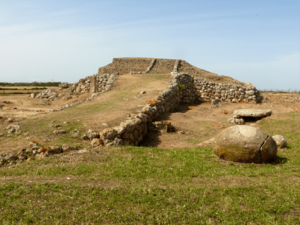
Before the Nuragic civilization, people lived on Sardinia during the Stone Age. They came from Europe and the Mediterranean area. Over time, different cultures grew on the island, like the Ozieri culture (around 3200−2700 BCE). These early people farmed, raised animals, fished, and traded with other lands. When people learned to work with metals, they started making silver and copper tools and weapons.
Around 4000 BCE, Sardinia became one of the first places in the world to extract silver. This shows how skilled these early islanders were.
From this period, we can still see hundreds of tall standing stones called menhirs. There are also many ancient tombs carved into rocks, known as domus de Janas (which means "fairy houses"). Another amazing structure is the stepped pyramid of Monte d'Accoddi. This pyramid looks a bit like ancient buildings found in Mesopotamia, suggesting that ideas might have traveled from the Eastern Mediterranean.
Around 2000 BCE, a new culture called the Beaker culture arrived in Sardinia. They came from different parts of Europe, bringing new ideas and ways of life.
The Nuragic Era Begins
Early Bronze Age Developments
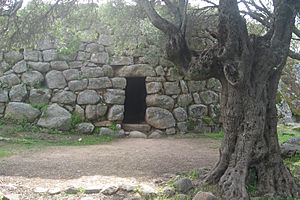
The Bonnanaro culture (around 1800–1600 BCE) was the last part of the Beaker culture in Sardinia. It had many things in common with cultures in northern Italy. New people arrived on the island, bringing new ideas about religion, technology, and daily life.
The use of bronze became very important. Bronze is a strong metal made from copper and tin. It was great for making tools for farming, hunting, and fighting.

During this time, the first "proto-nuraghes" were built. These were platform-like buildings that were the very first step towards the famous nuraghe towers. They looked different from the later, more classic nuraghes, with an irregular shape. They were mostly found in the central-western part of Sardinia.
Middle and Late Bronze Age: The Nuraghes Rise
The true nuraghes started appearing around the middle of the 2nd millennium BCE. These are huge stone towers shaped like a cone. Each nuraghe had at least one round room inside, called a tholos chamber. The biggest ones could have up to three tholos rooms stacked on top of each other. You can find nuraghes all over Sardinia, with about one for every three square kilometers!
Early Greek writers wondered about these mysterious towers. They thought they were built by a legendary craftsman named Daedalus.
Today, experts believe nuraghes were built as defensible homes. They likely included spaces for living, storing food, and keeping animals.
Later, in the second half of the 2nd millennium BCE, villages grew around some of these nuraghes. To make them stronger, new towers were often added to the original ones. These towers were connected by thick walls, creating a "complex nuraghe."
Some of the most famous nuraghes include Su Nuraxi at Barumini, Santu Antine at Torralba, and Nuraghe Losa at Abbasanta. The largest nuraghes, like Nuraghe Arrubiu, could be as tall as a seven-story building (25–30 meters). They might have had five main towers and many layers of protective walls. Some modern Sardinian villages might even have grown directly from ancient Nuragic settlements.
Sardinia had many mines, especially for copper and lead. The Nuragic people became very skilled at working with metals. They were major metal producers in Europe and made many different bronze objects. These included new weapons like swords and daggers, as well as tools, jewelry, and small statues. They even made votive boats, showing their strong connection to the sea. They traded these metal goods across the Mediterranean Sea.
The Sea Peoples Connection
During the late Bronze Age (around 14th–12th centuries BCE), a group known as the "Sea Peoples" caused a lot of trouble in the ancient world. They attacked powerful empires like the Mycenaeans and Hittites, and even Egypt. Some historians believe that the Sherden, one of the main groups of Sea Peoples, were actually Nuragic Sardinians. This idea is still debated, but it suggests that Nuragic Sardinians traveled far across the eastern Mediterranean Sea.
Evidence for this comes from Nuragic pottery found in places like Tiryns in Greece and Kommos on Crete. This shows that the Nuragic people were part of a large trade network.
Some archaeologists even think that a site in Israel, called "El-Ahwat," might have been a Nuragic settlement. This would mean that Nuragic people traveled very far from Sardinia.
The Iron Age: New Beginnings
From about 900 BCE to 500 BCE, during the Iron Age, the Nuragic civilization changed. They started making finer pottery and even better tools and weapons.
Trade grew, and their metal products were sent all over the Mediterranean, from the Near East to Spain. Villages became larger, and the population increased. People stopped building new nuraghes, and many old ones were left empty. Instead of large group burials, people started having individual tombs.
A big change during this time was how society was organized. Villages had a kind of "parliament" where important leaders met to discuss alliances, wars, and trade deals.
Carthaginian and Roman Conquests
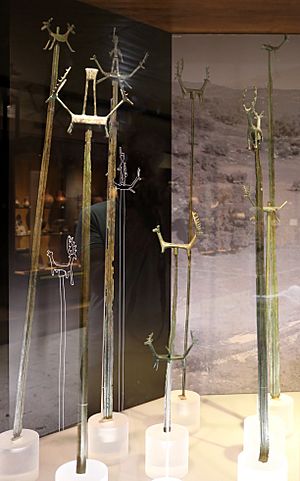
Around 900 BCE, the Phoenicians, who were great sailors and traders, began visiting Sardinia more often. They set up trading posts along the coast in places like Caralis (modern Cagliari) and Tharros.
Later, the Carthaginians tried to conquer Sardinia. In 540 BCE, a Carthaginian general named Malchus led an expedition, but it failed. Later, in 509 BCE, another Carthaginian general, Mago, launched a new attack. The Carthaginians eventually defeated the Sardinians and took control of the coastal areas and mines. However, the Nuragic culture likely continued to thrive in the mountainous parts of the island.
In 238 BCE, the Carthaginians lost a war to the Romans and had to give Sardinia to Rome. Sardinia became a Roman province. Even then, ancient writers noted that the Nuragic culture still survived in the island's interior, showing its strength and resilience.
Nuragic Society
Religion was very important in Nuragic society. Some experts even think it might have been a theocracy, meaning religious leaders had a lot of power.
Bronze statues from this time show different people in society. There are chiefs wearing cloaks and carrying staffs, as well as miners, craftspeople, musicians, and many warriors. This suggests it was a society where fighting was common, with clear military groups like archers and foot soldiers. Women might have had important roles as priests. The statues also give us clues about their hairstyles and clothing.
Nuragic Villages
The Nuragic civilization was probably organized into clans, with each clan led by a chief. The chief likely lived in the complex nuraghe, while ordinary people lived in nearby villages. Their homes were usually round stone houses with straw roofs. These look similar to the pinnettas used by shepherds in Sardinia today.
Later, houses became more complex, with several rooms often built around a central courtyard. In some coastal settlements, there were even special buildings for storing valuable metals, food, and other goods. These were built around large squares, which archaeologists believe were marketplaces. The Nuragic people were also good at managing water, with many nuraghes having wells and drainage systems. They even built an aqueduct, a system to carry water, at a place called Gremanu.
By the end of the Bronze Age, some Nuragic settlements started to look like small towns. They had paved squares, streets, and special workshops for metalworking.
Nuragic Tribes
For a long time, Sardinia was home to one large cultural group: the Nuragic people. Centuries later, Roman writers described the island as having many different tribes. These tribes kept their own identities and often fought each other for land. The most important Nuragic tribes mentioned were the Balares, the Corsi, and the Ilienses. The Ilienses were especially resistant to Roman rule.
- The Ilienses lived in central-southern Sardinia. Ancient writers said they were never fully conquered by the Carthaginians or Romans.
- The Balares lived in the northern parts of the island. They might have been related to the people who built similar stone towers (talaiots) in the Balearic Islands.
- The Corsi lived in the northernmost part of Sardinia and also on the island of Corsica.
Nuragic Culture
Religion and Beliefs
Animals like the bull were very important in Nuragic religion. They were often shown on ships and bronze vases used in religious ceremonies. Small bronze statues show half-man, half-bull figures, and creatures with four arms and eyes. These likely had special meanings in their myths. The dove was another sacred animal. Small carved discs with geometric patterns, called pintadera, might also have been used in religious rituals.
A key part of Nuragic religion was about fertility, linking the male power of the Bull-Sun with the female power of Water-Moon. They likely worshipped a Mother Goddess and a Father God. Important heroes like Norax and Sardus were also seen as gods.
Archaeological digs show that Nuragic people gathered at special holy places at certain times of the year. These places often had stone steps for sitting and a sacred pit. In some holy areas, like Gremanu, rectangular temples were found. These temples might have held a holy fire. The gods they worshipped are unknown, but they might have been connected to water or to the sun and moon.
Some large sanctuaries, like Santa Vittoria near Serri, might have been meeting places for different clans from across the island. Here, they would make alliances, decide on wars, or arrange trade deals.
Holy Wells
The holy wells were special buildings used for worshipping water. They were built with advanced techniques, similar to the nuraghes. The main part of a holy well was a circular room with a domed roof and a hole at the top. A grand staircase led down to this underground room, which collected water from a sacred spring. Outside, there were stone benches where people would place offerings. Some sites also had altars for sacrifices.
Starting in the late Bronze Age, a unique type of round building with a central basin appeared in Nuragic villages. A great example is the ritual fountain of Sa Sedda e Sos Carros. Here, water flowed from ram-shaped spouts into the basin through lead pipes. Some archaeologists think these buildings might have been like ancient thermal baths.
Megaron Temples
These special temples, found in different parts of Sardinia, were likely dedicated to the cult of healing waters. They have a long, rectangular shape, with walls that spread outwards. Some, like the temple of Malchittu, have a rounded end, while others, like Sa Carcaredda, end in a circular room. They were often surrounded by sacred areas. The largest and best-preserved of these temples is called Domu de Orgia.
Giant's Graves

The "giant's graves" were large tombs where many people were buried together. We don't know their exact purpose, but they might have developed from earlier stone tombs. They were used throughout the Nuragic era. These tombs were often shaped like a bull's head.
Tall stone sculptures, called betili, were sometimes placed near the entrance. Some tombs were built with very carefully shaped stones, showing great skill.
Nuragic Art
Bronze Statuettes
The bronzetti are small bronze statues, usually up to 39 cm (15 inches) tall. They were made using a technique called "lost-wax casting." These statues show scenes from daily life, people from different social classes, animals, gods, and even ships.
Most of them have been found in Sardinia. However, many have also been discovered in Etruscan sites in central Italy, showing that the Nuragic people traded their art far and wide.
Giants of Mont'e Prama
The Giants of Mont'e Prama are a group of large stone statues, some as tall as 2.5 m (8.2 ft). They were found in 1974 near Cabras. These statues show warriors, archers, wrestlers, and boxers with shields. There are also models of nuraghes.
Experts believe these statues were made between the 11th and 8th century BCE. If this is true, they would be some of the oldest human-like sculptures in the Mediterranean, even older than the famous kouroi statues of ancient Greece.
The statues have unique disc-shaped eyes and clothing that looks like it came from the East. They might have shown mythological heroes guarding a tomb, or perhaps they were statues of Nuragic gods. Their discovery proved that the Nuragic civilization kept its unique style and developed new ones, even when the Phoenicians started to colonize parts of Sardinia.
Nuragic Ceramics
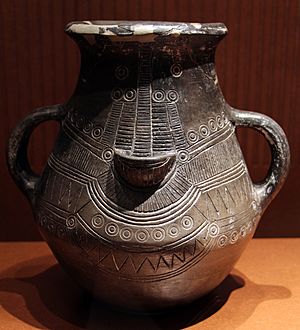
Nuragic artisans were very skilled at decorating pottery. They created beautiful patterns on lamps, pear-shaped vessels (which are unique to Sardinia), and askos (a type of pouring vessel). Pottery from other cultures, like the Mycenaeans, has also been found in Sardinia, and Nuragic pottery has been found in other parts of the Mediterranean. This shows that Sardinia was well connected to ancient trade routes.
Nuragic Language
We don't know what language (or languages) the Nuragic people spoke because they didn't leave any written records from that time. However, some recent studies suggest that around the 8th century BCE, they might have started using an alphabet similar to an early Greek alphabet.
Some experts believe the ancient Sardinian language was similar to Proto-Basque or ancient Iberian. Others think it might be related to the Etruscan language. It's also possible that there were different languages spoken in different parts of Nuragic Sardinia.
Nuragic Economy
The Nuragic people mainly made their living from farming and raising animals. They were also good at fishing. New studies suggest they were the first to grow grapes for wine in the western Mediterranean. They also produced alcoholic drinks like wine and beer. They even grew melons, which were probably brought from the Eastern Mediterranean.
About 60% of Sardinia's land was only good for raising cattle and sheep. Owning cattle might have shown how important a person was in society. The discovery of ancient roads for wagons suggests they had a well-organized society. Marks found on metal blocks show they used a number system for counting.
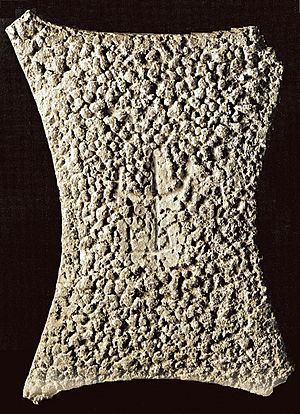
Sailing was very important to the Nuragic people. Anchors weighing up to 100 kg (220 lb) have been found along the coast, suggesting they had strong ships that could be up to 15 meters (49 feet) long. These ships allowed them to travel all over the Mediterranean Sea. They traded with the Mycenaean civilization, Spain, Italy, Cyprus, and Lebanon. For example, copper blocks from Cyprus have been found in Sardinia. In return, Nuragic bronze and pottery have been found in Greece, Cyprus, Spain, and Etruscan cities in Italy.
Sardinia was rich in metals like lead and copper. The Nuragic people were excellent metalworkers, making many bronze weapons. The "golden age" of the Nuragic civilization, around the late 2nd millennium BCE, was probably when they mined the most metals.
They used a lot of bronze, which needed tin. Since tin wasn't common in Sardinia, this shows they were very good at trading for the resources they needed. A study in 2013 found that most of the copper used in ancient Sweden during the Nordic Bronze Age came from Sardinia and Spain! Iron working also started on the island around the 13th century BCE.
Nuragic People: Their Origins
Recent studies looking at ancient DNA have shown that the Nuragic people were mostly related to the early farmers who lived in Sardinia during the Neolithic period. These early farmers were similar to people from Spain and southern France. This means there was a strong connection between the Nuragic civilization and the very first people who settled on the island. Unlike many other Bronze Age groups in Europe, the Nuragic people had very little ancestry from people who came from the steppes (grasslands) of Eastern Europe.
Some studies suggest that a small amount of new genetic material might have come from the Italian peninsula starting around the Copper Age.
Studies on the physical appearance of Nuragic people, based on their DNA, show that about 16% had blue eyes, and 9% had blond or dark blond hair. Most had dark eyes and dark brown or black hair. Their skin color was mostly intermediate or dark.
See also
 In Spanish: Cultura nurágica para niños
In Spanish: Cultura nurágica para niños
- Nuraghe
- History of Sardinia
- List of Nuragic tribes
- Paleo-Sardinian language
- Nuragic bronze statuettes
- List of ancient peoples of Italy
- Prehistoric Italy
Images for kids


